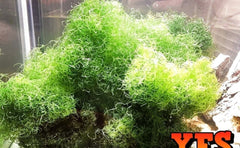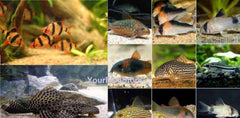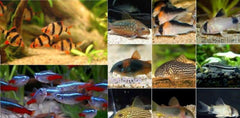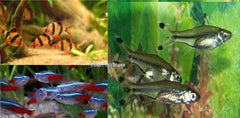X12 Upside Down Catfish 1" - 2" Each + x10 Assorted Freshwater Plants - Fresh Water
Ebay
$ 143.54

x12 Upside Down Catfish 1" - 2" Each - FRESH WATER LIVE FISH - FREE SHIPPING
+ x10 Assorted Freshwater Plants
This package is for x12 Upside Down Catfish
Minimum Tank Size: 30 gallons
Care Level: Easy
Temperament: Peaceful
Water Conditions: 75-82° F, KH 4-12, pH 6.0-7.5
Max. Size: 4"
Color Form: Black, White
Diet: Omnivore
Origin: Central Africa
A member of the Synodontis species, the upside-down catfish is aptly named for its upside down swimming posture. They are an extremely popular species that apparently have been admired for countless centuries, as their images have been found in ancient Egyptian art.
Considered a dwarf catfish, they reach an adult size of only three to four inches.
Like other members of the Mochikidae family, they have large eyes, a large adipose fin, a forked tail and three pairs of barbels. Their light brown colored body is covered with dark brown blotches of various sizes. Interestingly, the underside of the body has a darker hue, which is the opposite of fish that swim with their belly downwards. This reverse coloration serves to camouflage them when they swim upside down at the surface of the water.
However, don't be surprised if they swim normally for periods of time. This is particularly true when they want to graze the bottom of the tank for morsels of food. Young Upside Down Catfish do not swim upside down until they are several months old. Like other catfish, they have sharp fin spines that can cause injuries when moving them. Take care when netting or moving these fish.
Upside Down Catfish tend to be most active at dusk and during the night hours. Use a moonlight light tube to view their night activities.
Habitat/Care
Well suited to the aquarium environment, the Upside Down Catfish is peaceful and easy to care for, but it's best kept in small schools. They are good community fish when kept with other peaceful species. Water should be moderately soft and slightly acidic to neutral. Aquarium temperature is not critical. A well-planted tank is ideal, preferably using broad-leafed plants, as they like to browse the undersides of leaves. Driftwood, rock arches and caves that provide places to hide, are recommended. It is quite normal for this fish to hang out on the underside of rocks, leaves, and driftwood.
Diet
In nature, the Upside Down Catfish feeds primarily on insects at the surface of the water. They will also graze on algae to supplement their diet. In the aquarium environment, they adapt readily to all types of foods, from dry to live or frozen. For optimum health, provide a varied diet that includes insect larvae when possible, particularly mosquito larvae. Live foods will always be readily accepted.
Breeding
Only a limited number of successful spawnings have occurred in an aquarium. Females are larger, paler in coloration, and have a plumper more rounded body, particularly when ready to spawn.
Upside Down Catfish prefer cave spawning. Offer an overturned clay flowerpot or two or even some PVC pipe as a possible spawning location. Conditioning with live foods and softening the water to mimic spring rains will increase the odds for success.
Eggs will generally be laid in the roof of the cave. Parents may be left in the tank after spawning, as they will tend to the brood. The eggs hatch in approximately two to three days and the fry will feed off the yolk sac, which they carry for four days.
Once the yolk sac has been consumed, they will begin eating freshly hatched brine shrimp. In two months, the fry will begin swimming in the characteristic upside down fashion of adults.
QUESTIONS & ANSWERS
Have a Question?
Be the first to ask a question about this.















